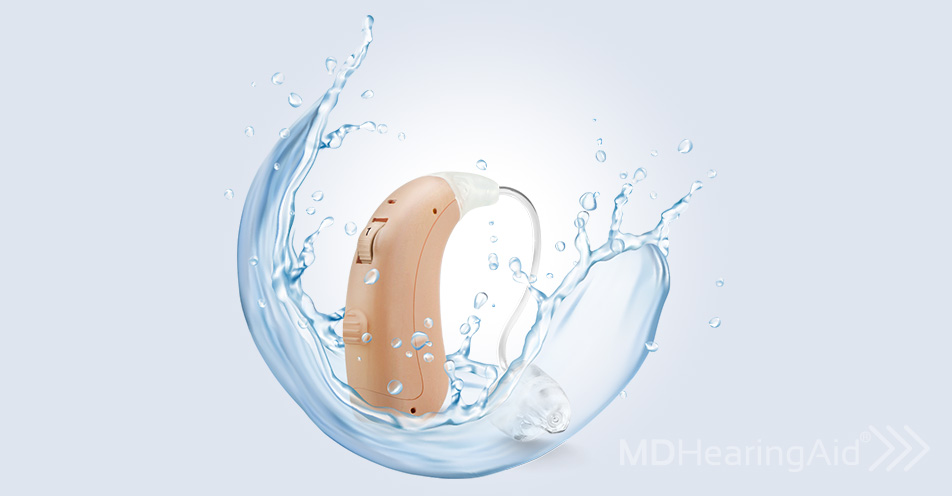With millions of people in the U.S. using hearing aids, there’s no reason why it should prevent you from living an active lifestyle—which is why many hearing aid wearers are interested in using waterproof hearing aids. But do waterproof hearing aids really work, or are they nothing but hype?
In this article, we’ll go over everything you need to know about waterproof hearing aids. What are waterproof hearing aids exactly, and what’s the difference between “waterproof” and “water-resistant” hearing aids? How do waterproof hearing aids work, and how should you care for them? We have all the answers below.
What are Waterproof Hearing Aids?
Waterproof hearing aids are hearing aids that can function normally while withstanding constant contact with water over an extended period of time. Most hearing aids (e.g. Eargo hearing aids) are not waterproof or water-resistant, which is why waterproof hearing aids have this special designation.
It should be noted that the term “waterproof” is slightly misleading, since no product or object can truly be considered waterproof over a long period of time (i.e. days, months, or years). Even supposedly “waterproof” materials such as plastic, metal, and glass have microscopic pores that allow for a slight degree of permeability.
The International Concrete Repair Institute defines the term “waterproof” as “impervious to water either in a liquid or vapor state.” What’s more, the organization discourages the use of “waterproof” as a description, adding: “Since nothing can be completely ‘impervious’ to water under infinite pressure over infinite time, this term shall not be used.”
Still, because the term “waterproof hearing aids” is so widespread when looking to purchase hearing aids online, we’ll continue to use the term for convenience in the rest of this article.
What's the Difference Between Waterproof and Water-Resistant Hearing Aids?
Although many people use the terms interchangeably, it’s important to distinguish the difference between “waterproof” and “water-resistant” hearing aids:
- Water-resistant hearing aids (e.g. MDHearing VOLT+) have some measure of protection against water damage. However, they are not guaranteed to block all water from entering the device, and are not guaranteed to work over an extended period of time. Some hearing aid manufacturers may also use the terms “moisture-resistant,” “water-repellent,” or “showerproof” as a synonym for “water-resistant.”
- Waterproof hearing aids are hearing aids that can survive submersion in water for an extended period of time. The term “waterproof” always indicates a higher degree of water protection than an object or material that is merely “water-resistant.”
The vast majority of hearing aids with water protection on the market today—perhaps even all of them—are actually water-resistant, not truly waterproof. This is true even if the manufacturer itself uses the “waterproof” description as a marketing ploy. The problem is that “waterproof” and “water-resistant” aren’t technical terms, so there’s no clear-cut barrier between them.
Fortunately, there’s a way for you to cut through the marketing hype and independently assess the hearing aid’s degree of water resistance, as we’ll discuss in the next section.
IPX Ratings for Waterproof Hearing Aids
If you’re looking to purchase waterproof hearing aids, you should always check the product’s IPX rating. So what is an IPX rating exactly?
Modern hearing aids need to go through a rigorous testing process before they’re approved for purchase by the general public. These tests are carried out by certified independent laboratories in accordance with standards from the International Electrotechnical Commission (IEC), which gives an IPX rating to each hearing aid based on how well it resists water, dust, and other foreign particles. The IP stands for “Ingress Protection,” i.e. how easy it is for foreign objects and materials to enter the hearing aid.
Every device tested by the IEC receives an IPX rating that consists of two digits:
- The first digit ranges from 0 to 6, and assesses the device’s ability to resist solid particles, such as dust.
- The second digit ranges from 0 to 9, and assesses the device’s ability to resist water and other liquids.
For example, ReSound hearing aids have an IPX rating of IP57--as does the MDHearing VOLT+--which means that they protect against most dust and particles (as denoted by the digit “5”), and can be immersed in water to a depth of 1 meter for 30 minutes (as denoted by the digit “7”). The complete meanings of the second digit are as follows:
- 0: No water protection.
- 1: Protection from vertically falling water droplets.
- 2: Protection from water droplets falling at angles up to 15 degrees.
- 3: Protection from sprays at angles up to 60 degrees.
- 4: Protection from splashes at all angles.
- 5: Protection from jets at all angles for a duration of 3 minutes.
- 6: Protection from high-pressure jets at all angles for a duration of 3 minutes.
- 7: Protection from being submerged in water up to 1 meter for a duration of 30 minutes.
- 8: Protection from being submerged in water up to 1 meter for a continuous period of time. The length of the test is determined by agreement with the device’s manufacturer, with at least a minimum of 31 minutes (and often up to 60 minutes) submerged.
In other words, if you’re looking to buy waterproof hearing aids, you should look for devices where the second digit in the IPX rating is as high as possible. Now for the next question: do waterproof hearing aids really work?
Do Waterproof Hearing Aids Work?
As of writing, there seem to be no truly waterproof hearing aids currently on the market, which makes it hard to say whether or not waterproof hearing aids actually “work.”
In 2013, Siemens released the Aquaris hearing aid, which it called “the industry’s first and only digital waterproof, dustproof, and shock-resistant hearing aid.” The Aquaris hearing aid had an IPX rating of IP68, which meant that it was both highly dust-resistant and water-resistant. However, the product was discontinued several years ago, and since then, no other hearing aid manufacturers have claimed that their product is “waterproof.”
According to a review of the Siemens Aquaris hearing aid by disability advocate Meriah Nichols, the device’s water resistance did appear to be functional, although the noise while using this feature was unpleasant:
The water sounds crinkly and metallic and rather than a lovely silence that goes with the feeling of water, it’s this jarring bunch of sound... I’m not getting the best quality sound, but since I’m a pretty active mom of 3 very active kids living in one of the rainiest parts of California with a lifestyle that revolves around water, I’ll take it.”
The good news is that if you’re looking to buy water-resistant hearing aids, you have several options available. The Phonak Naída, which was launched in 2007, has an IP68 certification and is perhaps the first hearing aid to truly deserve the description “water-resistant.” Since then, hearing aids such as the Oticon Xceed and the Phonak Sky M have also received IP68 certification, which is enough to protect them from occasional and incidental contact with water.
How to Care for Waterproof Hearing Aids
Whether your hearing aids are waterproof or water-resistant, we don’t recommend testing it out for yourself for an extended period of time. Although the IPX rating theoretically gives waterproof hearing aids some degree of protection, these tests are performed in ideal laboratory conditions with purified water. If you try to reproduce these tests in the pool or ocean, you run the risk of damaging your hearing aid, as well as introducing particles and contaminants.
To increase the lifespan of your waterproof or water-resistant hearing aids, you have several options. Removing the batteries, wiping down the device with a clean cloth, and airing it out can help remove moisture and water more quickly. For faster results, you can use an ultraviolet clean and dry box that gently removes moisture and condensation with heat. Hearing aid covers, protectors, and sweatbands can also prevent water from entering the device in the first place.
Do You Need Waterproof Hearing Aids?
There are multiple reasons you might find waterproof hearing aids or water-resistant hearing aids appealing:
- You participate in a lot of aquatic activities: swimming, kayaking, water skiing, sailing, etc.
- You live in a place with a very humid or rainy climate, or you live close to a large body of water.
- You want to wear your hearing aids during strenuous exercise when you may sweat heavily, or you have a condition such as hyperhidrosis that causes excessive sweating.
- You’re worried about your hearing aids suffering accidental damage or destruction from water or other liquids (for example, dropping them in a puddle, or wearing them in the shower).
As with any other product, you need to weigh the pros of having waterproof or water-resistant hearing aids against the potential downsides. Due to the increased technical complexity and the materials involved, water-resistant hearing aids are usually more expensive. In addition, many hearing aid models today include some degree of moisture resistance that can protect them during brief contact with water. (For more information, check out our hearing aid buyer’s guide.)
Still, if you’re concerned about the longevity of your hearing aids, and if one or more of the reasons above applies to you, then water-resistant hearing aids may be the right choice.
Interested in a water-resistant hearing aid? See if the MDHearing VOLT+ is right for you!
LEARN MORE ABOUT THE VOLT+

